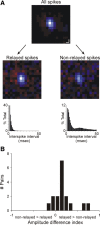Spike timing and information transmission at retinogeniculate synapses
- PMID: 20943897
- PMCID: PMC2970570
- DOI: 10.1523/JNEUROSCI.0909-10.2010
Spike timing and information transmission at retinogeniculate synapses
Abstract
This study examines the rules governing the transfer of spikes between the retina and the lateral geniculate nucleus (LGN) with the goal of determining whether the most informative retinal spikes preferentially drive LGN responses and what role spike timing plays in the process. By recording from monosynaptically connected pairs of retinal ganglion cells and LGN neurons in vivo in the cat, we show that relayed spikes are more likely than nonrelayed spikes to be evoked by stimuli that match the receptive fields of the recorded cells and that an interspike interval-based mechanism contributes to the process. Relayed spikes are also more reliable in their timing and number where they often achieve the theoretical limit of minimum variance. As a result, relayed spikes carry more visual information per spike. Based on these results, we conclude that retinogeniculate processing increases sparseness in the neural code by selectively relaying the highest fidelity spikes to the visual cortex.
Figures






Similar articles
-
Efficacy of retinal spikes in driving cortical responses.J Neurosci. 2003 Sep 17;23(24):8547-57. doi: 10.1523/JNEUROSCI.23-24-08547.2003. J Neurosci. 2003. PMID: 13679424 Free PMC article.
-
The Augmentation of Retinogeniculate Communication during Thalamic Burst Mode.J Neurosci. 2019 Jul 17;39(29):5697-5710. doi: 10.1523/JNEUROSCI.2320-18.2019. Epub 2019 May 20. J Neurosci. 2019. PMID: 31109958 Free PMC article.
-
Transmission of spike trains at the retinogeniculate synapse.J Neurosci. 2007 Mar 7;27(10):2683-92. doi: 10.1523/JNEUROSCI.5077-06.2007. J Neurosci. 2007. PMID: 17344406 Free PMC article.
-
Dynamic properties of thalamic neurons for vision.Prog Brain Res. 2005;149:83-90. doi: 10.1016/S0079-6123(05)49007-X. Prog Brain Res. 2005. PMID: 16226578 Review.
-
Mapping the primate lateral geniculate nucleus: a review of experiments and methods.J Physiol Paris. 2014 Feb;108(1):3-10. doi: 10.1016/j.jphysparis.2013.10.001. Epub 2013 Nov 21. J Physiol Paris. 2014. PMID: 24270042 Free PMC article. Review.
Cited by
-
Interspike interval based filtering of directional selective retinal ganglion cells spike trains.Comput Intell Neurosci. 2012;2012:918030. doi: 10.1155/2012/918030. Epub 2012 Aug 2. Comput Intell Neurosci. 2012. PMID: 22919373 Free PMC article.
-
Effects of cortical feedback on the spatial properties of relay cells in the lateral geniculate nucleus.J Neurophysiol. 2013 Feb;109(3):889-99. doi: 10.1152/jn.00194.2012. Epub 2012 Oct 24. J Neurophysiol. 2013. PMID: 23100142 Free PMC article.
-
The timing of vision - how neural processing links to different temporal dynamics.Front Psychol. 2011 Jun 30;2:151. doi: 10.3389/fpsyg.2011.00151. eCollection 2011. Front Psychol. 2011. PMID: 21747774 Free PMC article.
-
Visual Functions of the Thalamus.Annu Rev Vis Sci. 2015 Nov;1:351-371. doi: 10.1146/annurev-vision-082114-035920. Annu Rev Vis Sci. 2015. PMID: 28217740 Free PMC article.
-
Sparse and dense coding of natural stimuli by distinct midbrain neuron subpopulations in weakly electric fish.J Neurophysiol. 2011 Dec;106(6):3102-18. doi: 10.1152/jn.00588.2011. Epub 2011 Sep 21. J Neurophysiol. 2011. PMID: 21940609 Free PMC article.
References
Publication types
MeSH terms
Grants and funding
LinkOut - more resources
Full Text Sources
Research Materials
Miscellaneous
